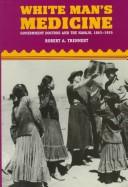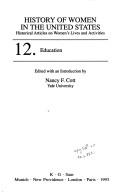| Listing 1 - 4 of 4 |
Sort by
|

ISBN: 0585376174 9780585376172 0826318398 9780826318398 0826331483 Year: 1998 Publisher: Albuquerque, NM : University of New Mexico Press,
Abstract | Keywords | Export | Availability | Bookmark
 Loading...
Loading...Choose an application
- Reference Manager
- EndNote
- RefWorks (Direct export to RefWorks)
In 1863 the Dine began receiving medical care from the federal government during their confinement at Bosque Redondo. Over the next ninety years, a familiar litany of problems surfaced in periodic reports on Navajo health care: inadequate funding, understaffing, and the unrelenting spread of such communicable diseases as tuberculosis. In 1955 Congress transferred medical care from the Indian Bureau to the Public Health Service. The Dine accepted some aspects of western medicine, but during the nineteenth century most government physicians actively worked to destroy age-old healing practices. Only in the 1930s did doctors begin to work with - rather than oppose - traditional healers. Medicine men associated illness with the supernatural and the disruption of nature's harmony. Indian service doctors familiar with Navajo culture eventually came to accept the value of traditional medicine as an important companion to the scientific-based methods of the western world.
Navajo Indians --- Public health administration --- Indians, North American --- Delivery of Health Care --- Public Health Administration --- American Native Continental Ancestry Group --- Organization and Administration --- Patient Care Management --- Health Care Quality, Access, and Evaluation --- Health Care --- Continental Population Groups --- Health Services Administration --- Population Groups --- Persons --- Named Groups --- Ethnic Minorities & Public Health --- Public Health --- Health & Biological Sciences --- Administration, Health Services --- Health Services --- Race --- Racial Stocks --- Continental Population Group --- Group, Continental Population --- Groups, Continental Population --- Population Group, Continental --- Population Groups, Continental --- Races --- Racial Stock --- Stock, Racial --- Stocks, Racial --- Race Factors --- Community-Based Distribution --- Contraceptive Distribution --- Delivery of Healthcare --- Dental Care Delivery --- Distribution, Non-Clinical --- Distribution, Nonclinical --- Distributional Activities --- Healthcare --- Healthcare Delivery --- Healthcare Systems --- Non-Clinical Distribution --- Nonclinical Distribution --- Delivery of Dental Care --- Health Care Delivery --- Health Care Systems --- Activities, Distributional --- Activity, Distributional --- Care, Health --- Community Based Distribution --- Community-Based Distributions --- Contraceptive Distributions --- Deliveries, Healthcare --- Delivery, Dental Care --- Delivery, Health Care --- Delivery, Healthcare --- Distribution, Community-Based --- Distribution, Contraceptive --- Distribution, Non Clinical --- Distributional Activity --- Distributions, Community-Based --- Distributions, Contraceptive --- Distributions, Non-Clinical --- Distributions, Nonclinical --- Health Care System --- Healthcare Deliveries --- Healthcare System --- Non Clinical Distribution --- Non-Clinical Distributions --- Nonclinical Distributions --- System, Health Care --- System, Healthcare --- Systems, Health Care --- Systems, Healthcare --- Healthcare Quality, Access, and Evaluation --- Care Management, Patient --- Management, Patient Care --- Administration and Organization --- Administrative Technics --- Administrative Techniques --- Coordination, Administrative --- Logistics --- Supervision --- Technics, Administrative --- Techniques, Administrative --- Administration --- Administrative Coordination --- Administrative Technic --- Administrative Technique --- Technic, Administrative --- Technique, Administrative --- Administration, Public Health --- Amerinds, North American --- American Indian, North --- American Indians, North --- Amerind, North American --- Indian, North American --- North American Amerind --- North American Amerinds --- North American Indian --- North American Indians --- Health administration --- Health care administration --- Health sciences administration --- Medical care --- Public health --- Health services administration --- Diné Indians (Navajo) --- Navaho Indians --- Athapascan Indians --- Indians of North America --- Person --- Indigenous Population --- Native-Born --- Natives --- Tribes --- Group, Population --- Groups, Population --- Indigenous Populations --- Native Born --- Population Group --- Population, Indigenous --- Populations, Indigenous --- History. --- Health and hygiene. --- Government policy --- History --- Health and hygiene --- organization & administration --- United States. --- history. --- Southwestern United States. --- Southwest US --- Southwest U.S. --- Medical care.
Book
ISBN: 9786610501106 1280501103 1457110938 0870817043 Year: 2001 Publisher: Boulder, Colorado : University Press of Colorado,
Abstract | Keywords | Export | Availability | Bookmark
 Loading...
Loading...Choose an application
- Reference Manager
- EndNote
- RefWorks (Direct export to RefWorks)
Riding the High Wire is the first comprehensive history of aerial mine tramways in the American West, describing their place in the evolution of mining after 1870. Robert A. Trennert shows how the mid-nineteenth century development of wire rope manufacturing made it possible for American entrepreneurs such as Andrew S. Hallidie and Charles Huson to begin erecting single-rope tramways in the 1870s and 1880s.
Aerial tramways --- Mine haulage --- Mine haulage --- History --- History --- History --- West United States.
Book

ISBN: 9783110978933 Year: 2012 Publisher: Berlin Boston
Abstract | Keywords | Export | Availability | Bookmark
 Loading...
Loading...Choose an application
- Reference Manager
- EndNote
- RefWorks (Direct export to RefWorks)


ISBN: 9783110978933 9783598414664 Year: 2012 Publisher: Berlin ;; Boston K. G. Saur
Abstract | Keywords | Export | Availability | Bookmark
 Loading...
Loading...Choose an application
- Reference Manager
- EndNote
- RefWorks (Direct export to RefWorks)
| Listing 1 - 4 of 4 |
Sort by
|

 Search
Search Feedback
Feedback About UniCat
About UniCat  Help
Help News
News